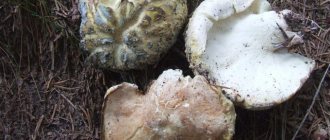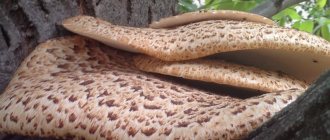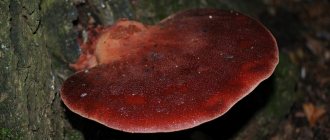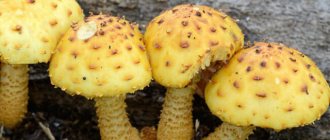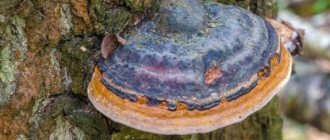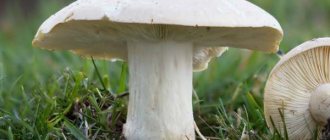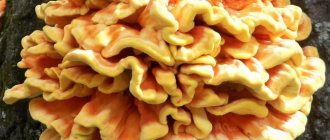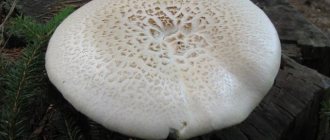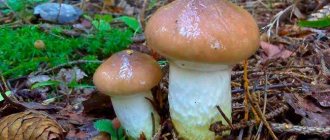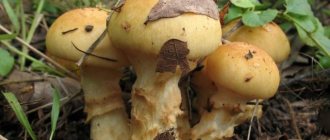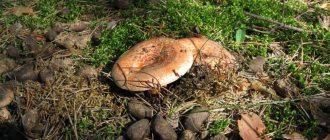About one of the most delicious and aromatic representatives of the tree mushroom family - Scaly tinder fungus. The area and timing of its growth, nutritional and medicinal properties, and the technology for preparing this mushroom for consumption.
Walking through the Russian forest, you can often come across funny half-plates that seem to have grown into tree trunks. They can grow singly or piled on top of each other in tall, multi-tiered structures. These are tinder fungi - wood fungi - parasites. There are many species of them, and they are all similar to each other, but one of the types of tinder fungus is difficult to confuse with its fellows because of its pronounced individual coloring, this
Scaly tinder fungus - a spotted woody delicacy
The scaly polypore or Cerioporus Squamosus from the genus Cerioporus, family Polyporaceae is a conditionally edible mushroom, valued by many lovers for its delicate taste and aroma. This mushroom is also called the Variegated Polypore, and among the people it has many traditional nicknames - Hare, Spotted, Vyazovik, Pestrushka.
Description of the scaly tinder fungus
The scaly tinder fungus has an unusual appearance, which makes it easy to distinguish it from other varieties of the Polyporaceae family.
Description of the cap
Its diameter ranges from 10 to 40 cm. The cap is leathery, dense and fleshy, shaped like a fan. It is light yellow in color interspersed with a dark brown hue, reminiscent of scales arranged symmetrically in a circle. The cap is slightly depressed at the base. In young fruiting bodies it is kidney-shaped, but expands as it grows.
The flesh of the variegated mushroom is dense, with a pleasant aroma. As it grows it becomes woody
The photo of the scaly tinder fungus shows that the spores in the cap are large and angular in shape.
Description of the leg
The leg reaches 10 cm in length and does not exceed 4 cm in diameter. At the base the leg is denser, at the top it is like a mesh, loose. Below it has a black-brown color, but at the cap its color changes to whitish.
The scaly polypore has both straight and curved legs. More often they grow to the side of the cap
Varieties of scaly polypores
There are fruiting bodies related to the pest:
- Lumpy tinder fungus. It belongs to the category of inedible, prefers to grow at the roots of trees. The hat has a fan shape and is hard to the touch. Its color is very diverse: fruiting bodies are found in various shades of brown and orange.
- The cellular tinder fungus belongs to the category of edible fruiting bodies. His hat is oval-shaped, orange, reddish or yellow. Dark depressions are visible on its surface. The leg is smooth and short. The pulp of this variety is very hard and does not have a pronounced taste or aroma.
Important! Although the honeycomb polypore is edible, due to its low taste characteristics it is preferred not to collect it.
Where and how do scaly polypores grow?
Mushrooms prefer to grow on trees whose immunity is weakened. It is possible to meet them in parks and deciduous forest plantations.
According to the photo and description, the scaly tinder fungus prefers to grow singly or in groups, and is prone to the formation of fan-shaped colonies
Fruiting for scaly polypores lasts from May to August. Most often, mushrooms are found in the southern regions. This variety practically does not grow in the middle zone. Mushroom pickers also harvest in Europe, North America, Crimea, Kamchatka, the Far East and the Krasnodar Territory.
Most often it grows on elm, maple and beech, and is not found on coniferous trees.
Doubles and their differences
Among the fungi that are similar to the variegated variegated mushroom is the tuberous tinder fungus. His cap grows from 5 to 15 cm and has a yellow-reddish tint. Over its entire surface there are small brownish scales, forming a symmetrical pattern. As the fungus grows, it becomes less noticeable.
The main difference from the scaly polypore is the presence of large pores and a stalk located in the center.
The mushroom has a smaller size
The scaly polypore's counterpart is edible, but it is rarely eaten: the fruiting bodies do not have a pronounced taste and are often attacked by pests in the early stages of development
False doubles of polyporus
The tinder fungus, like most mushrooms, has false doubles. The differences between these species can be most clearly seen in the photo.
Polypore honeycomb
Liver mushroom
The cellular polypore is an edible relative of the scaly polypore. The difference lies in the brighter color of the cap - in the cellular tinder fungus it is reddish-orange. Also, this mushroom, even at a young age, has a very hard fruiting body; the flesh of the cellular tinder fungus has a very faint odor and an inexpressive taste.
Liver mushroom is edible, with a delicate taste and a strong sour taste. It usually grows in the lower part of the trunk or at the roots. It is distinguished by an unusually bright color of the pulp, reminiscent of meat with whitish veins.
Dangerous doubles are clearly described in the table:
| Tinder fungus | The color of the mushroom cap ranges from bright red to brown. The fruiting body is sessile, fan-shaped. It most often grows in groups, bears fruit throughout the year on fallen trunks of deciduous trees and old stumps, most often on willows. |
| Sulfur-yellow tinder fungus | It cannot cause direct harm to health. But due to its sharp, bitter, unpleasant taste and disgusting smell, it can cause stomach cramps caused by pronounced individual intolerance. |
Why are scaly polypores dangerous for trees?
The fungus, growing on a tree, parasitizes it, sucking water and organic matter from it. The process lasts more than one year, so the initial signs of damage appear gradually.
The fungus continues to parasitize even on a dead host.
As the scaly tinder fungus matures, the tree gradually dries out, becomes brittle and breaks under the influence of weather conditions.
The activity of the tinder fungus, although destructive, brings benefits to the forest: old trees die, making room for new plantings.
Contraindications
This mushroom has no special contraindications, so standard safety rules for conditionally edible mushrooms apply to it.
- Not recommended for pregnant and lactating women.
- May cause complications in people with urolithiasis, chronic or acute gastrointestinal diseases.
- May cause an individual allergic reaction.
The Scaly tinder fungus is one of the most aromatic and tasty representatives of the tinder fungus family. Many lovers of quiet hunting are accustomed to ignoring tinder fungi, but those who are privy to the secret of the delicate aroma and taste of this inconspicuous tree inhabitant will never deny themselves the pleasure of enjoying them again.
Medicinal properties of scaly polypores
On the pharmaceutical market, fruiting bodies are added to various preparations aimed at restoring the functions of organs and systems lost due to poisoning.
Important! The fruiting bodies contain the substance lecithin, which is used to develop drugs that have an antitumor effect.
The scaly tinder fungus is capable of not only removing poisons, but also heavy metals and gases, and has an antioxidant effect.
In traditional medicine, decoctions and infusions are made on its basis to restore the functioning of the gallbladder, and ointments are also made for osteochondrosis, varicose veins and arthrosis. Scaly polypore is known as an antifungal agent.
Places of growth
The usual habitat of the pied variegated species is forests and parks with living and dead, weakened broad-leaved trees. Mainly on beech, maple and elm, the favorite tree is elm.
The fungus grows both in groups, forming small colonies, and singly. Humidity, temperature and light are important for it - the fruiting body does not develop well in the dark.
IMPORTANT! The polypore is distributed from the eastern rocky mountains of the United States and throughout Europe. Places of growth in the Russian Federation: Krasnodar Territory, Stavropol, Crimea, North Caucasus, Eastern Siberia, Kamchatka and the Far East.
The use of scaly polypores in folk medicine
The dosage and method of preparing tinctures and decoctions vary depending on the purpose.
Recipes:
- For constipation: dry the mushroom and grind it into powder, take a pinch daily in the morning with 100 ml of water for 7 days.
- For wounds: powder from fruiting bodies is sprinkled on the inflammation area, an aseptic bandage is applied on top, which is changed twice a day until complete healing.
- For insomnia: pour 180 g of raw material into 0.5 liters of vodka and leave for 3 days. After the time has passed, strain, take 1 tsp. per day an hour before bedtime, dissolving the medicine in 100 ml of water.
- For heart pathologies: 2 tsp. powder from the tinder fungus, pour ½ cup of water and leave for 2 days, then strain the infusion. Take 1 tbsp. l. three times a day before meals.
Water infusions should be taken within 1-2 days, alcohol tinctures are preserved during the course of treatment in glass containers
Recipes for making scaly polypores
The scaly polypore can be eaten, but it requires pre-treatment. The taste of the mushroom depends on the correctness of the procedure.
Cleaning and preparing mushrooms
In order to preserve the beneficial properties of tinder fungus as much as possible, you need to be able to prepare it correctly.
Only young fruiting bodies can be eaten: they are assigned the fourth edibility group
Old polypores are scaly and hard, which negatively affects their taste. They should be processed immediately after returning from the forest. To do this, the fruiting body, cleared of dirt and debris, is placed in water for 12-24 hours. If this procedure is neglected, the scaly polypore will become woody, which will negatively affect its taste.
Important! When soaking, the water should be changed every 1-1.5 hours.
At the end of the procedure, the mushroom should be pulled out, the scales removed from the cap, and the stem cut off. It is unsuitable for food as it is very hard.
How to make soup with scaly polypores
In order not to spoil the taste of the dish, young fruiting bodies should be used after pre-treatment.
Ingredients:
- mushroom – 0.5 kg;
- medium-sized carrots – 1 pc.;
- onion – 1 pc.;
- potatoes – 4 pcs.;
- greens to taste;
- vegetable oil.
Mushrooms should be thoroughly washed, stems cut off and scales removed. Grind the tinder fungus in any way.
In soup, the edible scaly polypore gives it a rich aroma and taste, so it is preferable to grate it.
Place a container of water on the stove and put mushrooms in it, lightly salt the broth. After the liquid boils, remove the foam that has formed on its surface with a slotted spoon. Then the soup needs to be simmered over low heat for 30 minutes.
While the broth is cooking, use a coarse grater to chop the carrots and cut the onion into cubes. Fry the vegetables in a small amount of oil.
The potatoes should be crushed, cut into cubes, then added to the broth along with onions and carrots. Simmer the soup for 15 minutes until the potatoes are ready.
Serve the soup on the table, first sprinkled with herbs.
How to cook fried scaly polypore mushrooms with onions
Main ingredients:
- scaly tinder fungus – 500 g;
- onion – 2 pcs.;
- greenery;
- salt pepper;
- vegetable oil.
Before cooking tinder fungi, they should be washed, chopped and boiled for 15-20 minutes.
Pour oil into a frying pan and heat well. Chop the onion as desired, then fry until golden brown. As the vegetable cooks, add mushrooms and simmer for 15 minutes.
When serving, sprinkle the finished dish with herbs.
Scaly tinder fungus stewed in sour cream
A common dish made from the scaly tinder fungus is pied fish stewed in sour cream.
Main ingredients:
- onion – 1 pc.;
- mushrooms – 0.5 kg;
- greenery;
- sour cream 20% – 200g;
- salt pepper;
- vegetable oil.
Grind the scaly polypore and boil it. Cut the onion into cubes and fry in a frying pan until transparent. Add mushrooms, salt and pepper to the vegetable, mix well. Simmer the dish over low heat for 10 minutes, then add sour cream and leave to simmer for another 10 minutes.
Sprinkle the finished mushrooms in sour cream with herbs; potatoes or rice are good as a side dish
Delicious cutlets made from scaly tinder fungi
The resulting cutlets can be used as a separate dish or you can prepare a side dish of potatoes for them separately.
Ingredients:
- onion – 1 pc.;
- garlic – 2-3 cloves;
- variegates – 500 g;
- egg – 1 pc.;
- bread – 50 g.
The mushrooms should first be boiled for 15-20 minutes, then minced through a meat grinder twice until you get “minced meat” of a uniform consistency.
To the scaly tinder fungus, add onion, garlic and bread, crushed into a pulp, and mix everything. Add egg, salt and pepper to the finished mixture. The finished mass should turn out pasty.
Pour oil into a frying pan and heat it thoroughly. Form cutlets from the mixture, roll them in breadcrumbs or corn flour, and fry until golden brown, covered.
It is recommended to serve the cutlets with salad; you can decorate them with herbs on top
Preparation of pickled scaly polypores
One way to add a piquant flavor to mushrooms is to marinate them.
Ingredients:
- boiled pestle – 0.5 kg;
- apple cider vinegar 5% – 80 g;
- garlic – 3 cloves;
- black peppercorns – 10 pcs.;
- vegetable oil – 120 ml;
- salt – 1 tsp;
- bay leaf – 4 pcs.;
- sugar – 2 tsp.
Prepare a frying pan, put garlic crushed through a press, chopped mushrooms and spices with oil and vinegar. Cover the ingredients with a lid and simmer for 10 minutes. Transfer the finished dish to a jar and leave in the refrigerator for 4 hours.
Peppers stuffed with scaly tinder fungi
Initially, boil mushrooms and rice in salted water. Grind the scaly polypore through a meat grinder along with onions and carrots, add salt, pepper and cooked rice to the mixture.
The pepper should be washed, core and seeds removed. Stuff the vegetables with prepared minced meat, place them in a cauldron and fill with water. Simmer the stuffed peppers for up to 20-25 minutes. 10 minutes before readiness, add tomato juice and chopped herbs to the dish.
Stuffed peppers can be served with herbs
What can you cook from scaly tinder fungus for the winter?
If it is not possible to devote time to preparing mushrooms, then they can be preserved for the winter by processing them in a certain way. There are 3 ways to create a blank, which will be discussed below.
Freezing
The scaly polypore should be boiled for 15-20 minutes, then cooled and cut into pieces, blotted with a napkin to remove excess moisture. The product should be placed in disposable containers of 300-500 g, then transferred to the freezer.
You can use freezer bags instead of disposable containers.
Pickling
To pickle tinder fungi, the following ingredients are needed:
- fruiting bodies – 3 kg;
- salt – 120 g;
- dill umbrellas;
- black pepper – 35 pcs.;
- garlic – 5 cloves;
- laurel leaf – 6 pcs.
Boil the mushrooms and cool slightly. Place bay leaf, chopped garlic, dill umbrellas, and pepper into the bottom of the container. Mushrooms are placed on top of the spices in layers, sprinkled with salt. Cover the container with a napkin, place the load on top and leave in a dark place for 30 days.
Drying
Drying pests should be as follows:
- rinse and dry the fruiting bodies;
- cut into pieces;
- string the mushrooms on a thread and hang them outside in the sun.
To prevent insects from accessing scaly polypores, they should be covered with gauze.
Is it possible to grow scaly polypores at home?
Cultivating the mushroom does not require much effort. To grow fruiting bodies, you should prepare sawdust, tree bark or shavings.
Growing stages:
- Pour boiling water over the substrate and cool.
- Squeeze the mixture and put it into a bag, add the mycelium there.
- Make ventilation holes in the bag, then take it to a room with a temperature of up to + 20 ° C and a humidity of 70-80%.
- The harvest can be harvested in 30-40 days.
If the technology is followed, tinder fungus can be grown in a garden plot
It is allowed to use bars or hemp as a substrate. Cuts are made in them, and then the mycelium is placed there. To prevent it from dying, you need to moisten it regularly.
Propagation and cultivation
In the natural environment, namekos are found in mixed forests, where high humidity levels are observed, reaching 90-95%. Being saprophytes, they prefer stumps and places near the roots of fallen trees. They grow in large colonies of several mushroom stalks, growing from a single base.
For culinary purposes, edible flake is grown artificially. When breeding under artificial conditions on sawdust and substrates obtained from broad-leaved species, mainly beech, special shelters and the mandatory use of air humidifiers are required.
